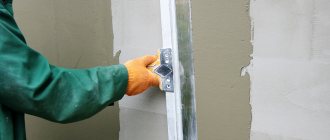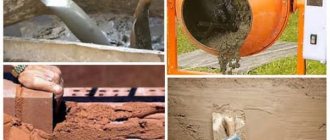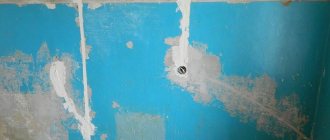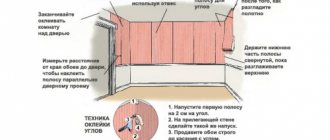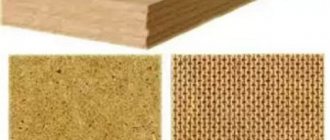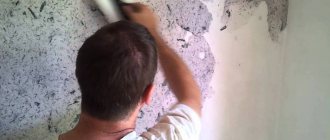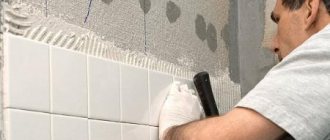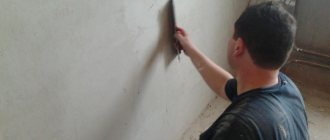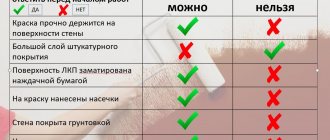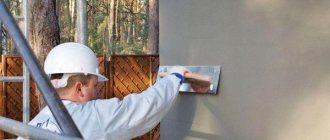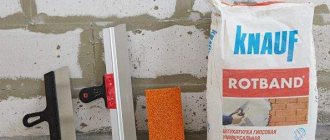How to properly plaster with finishing putty?
So, instructions on how to putty walls under wallpaper:
- We prepare the wall and apply a primer.
- We are waiting for it to dry completely. ...
- Apply a layer of finishing putty
. - We wait until it dries and sand it.
- We proceed to applying another layer, again wait for it to dry and sand.
Interesting materials:
How to send music via WhatsApp? How to add music to a slide in powerpoint? How to add music to your watch? How to add music from a computer to contact? How to add music to iCloud? How to add music to iMovie? How to add music to Canva? How to add music to facebook? How to add music to Filmora? How to add music to icloud?
Material characteristics
Polymer putties are intended for high-quality finishing of surfaces, filling small cracks, leveling depressions or for leveling unevenness with an ultra-thin layer, as finishers say, “to tear off”. Apply the putty to a layer of gypsum, cement plaster or directly on smooth bases (concrete, gypsum board, gypsum fiber board) after priming the surface with the appropriate composition. For monolithic concrete, a soil is used that creates roughness and increases the contact area of the base with the putty, and for plaster, gypsum board, gypsum fiber board - it reduces absorbency.
The basis of the mass of polymer putties is the filler. This can be finely ground marble, limestone, dolomite and similar light-colored materials. In addition to them, the composition includes polymer glue, stabilizer, plasticizer, and modifying additives. Putties are produced in the form of dry mixtures and plastic, ready-to-use masses.
ScionFresh putty stains can be removed with water, while dried ones can only be removed mechanically.
ShutterStock
When working with putties, tools made of stainless materials are used.
ShutterStock
Containers and tools are washed with water after completion of the process.
ShutterStock
To prepare a solution from a dry mixture, the contents of the package are poured into a container with water in the proportions specified by the manufacturer and stirred with a construction mixer until a homogeneous mass is obtained. In this case, obtaining high-quality putty largely depends on the qualifications and conscientiousness of the master.
Some manufacturers of ready-made putties allow them to be diluted with small portions of water (from 30 to 50 ml per 1 kg of weight). This way you get the most comfortable solution consistency for work. But due to excessive addition of liquid, the putty may lose its beneficial properties. This usually leads to increased shrinkage of the material and deterioration of its adhesion to the base. It is strictly not recommended to add anything other than a small amount of water to the putty. These actions may damage the product.
Ready-made polymer putties (paste-like) are prepared in production. To obtain a homogeneous mass from the filler of the smallest fractions and other components, a certain mixing speed and a special temperature regime are required, which cannot be achieved on site. Therefore, ready-made putties are somewhat more expensive than dry mixes.
However, they also save effort at the stage of preparing the mixture. It is not difficult to restore their uniform consistency and working properties of the composition after storage. It is simply mixed with a construction mixer at low speed. The elastic pasty mass is easily distributed over the base in a thin and even layer. It simultaneously levels out unevenness and eliminates the smallest surface defects, which is necessary for subsequent painting and wallpapering.
Sheetrock SuperFinish
On the Russian market, ready-made polymer putties are represented by many companies, including Knauf, Cedrus (Osnovit brand), Saint-Gobain (Weber brand), Starateli, Bergauf, Danogips, Henkel.
Ready-made putties
| Name | Rotband Pasta | Vetonit LR paste | LR pasta | SuperFinish | Ceresit IN 95 | "Elisilk" PA39 W |
| Manufacturer | KNAUF | Weber "Saint-Gobain" | Bergauf | Danogips | Henkel | "Osnovit" |
| Layer thickness, mm | 0,2—2 | 0,2—3 | 0,1—1 | Up to 2 | Until 3 | 0—2 |
| Consumption per layer 1 mm thick | 1.6 kg/m² | 1 l/m² | 1 kg/m² | 1 l/m² | 1.7 kg/m² | 1.6 kg/m² |
| Drying time 1 mm, h | 24 | 8 | 4 | 24 | 4,5 | 24 |
| Allowable freezing/thawing cycles | 5 | 10 | _ | 5 | Up to 5 | 10 |
| Packaging, kg | 18 | 20 | 25 | 18,1 | 25 | 28 |
| price, rub. | 831 | 1094 | 1037 | 1071 | 1485 | 1354 |
Purpose and application
The material is used for a wide variety of work.
Polymer putty is intended for leveling the base (walls, ceilings) before finishing (painting or gluing wallpaper, etc.). Using putty, you can eliminate defects (irregularities, chips, cracks), increase the waterproof characteristics of the surface, the level of sound and heat insulation of the room, etc.
When choosing a material, it is important to consider that such coating is performed for different types of surfaces and operating conditions.
According to purpose, the composition is divided into the following varieties:
- leveling (starting);
- special;
- universal;
- finishing.
Starting putty is used for rough finishing work. The material must be applied in a dense layer to eliminate defects. The composition is dense, holds its shape, does not shrink, and does not spread. After hardening, a durable putty coating is formed. The consumption of these mixtures is high. The composition contains coarse-grained components. The material is selected in accordance with the characteristics of the base, the application layer reaches 3-50 mm.
Finishing polymer putties help eliminate small defects, hide small cracks and form a smooth, even surface. The material is used after the rough coating and is final at the stage of leveling the walls and ceiling.
The universal composition can be used for leveling, eliminating small defects and finishing the panel.
Special putty products contain additional components to solve the required problems. Information about the purpose is indicated by the manufacturer on the label.
Mixtures are produced for finishing fireplaces, stoves with high heat resistance, swimming pools and rooms with high levels of humidity.
Advantages and disadvantages of polymer putties for interior work
Polymer putty for exterior use has the following advantages:
- the combination of plastic and elastic characteristics of the product allows you to apply the mass in a thin layer;
- the quality characteristics of the material make it possible to use the mixture in the treatment of rough substrates;
- easy application;
- plasticizers and modifiers in the putty provide reliable adhesion to the surface being treated;
- a high-quality applied product does not peel off;
- the absence of shrinkage allows you to accurately calculate the amount of work and prevents cracking of the coating;
- materials are distinguished by water-repellent properties, ensuring their versatility;
- a protective film is formed on the surface of the putty coating;
- the mixture can withstand temperature changes;
- the composition has fire-resistant characteristics and does not melt;
- the material is environmentally friendly, does not contain toxic substances, which means it is safe for indoor use;
- vapor permeability reduces the risk of mold;
- the finished composition retains its technical characteristics for 12 hours in a sealed container;
- Increasing sound and thermal insulation allows you to maintain a stable indoor microclimate.
The list of disadvantages includes the high price of the product.
Features of the gypsum-based mixture
Alabaster or gypsum composition of pure white or white with a slight yellowish color. Its main components are polymers and mineral fillers. A starting gypsum putty solution with a coarse consistency is designed to fill large cracks and joints. The mixture is used to level serious defects and level walls. On sealed and smooth walls, apply a primer, paint or wallpaper.
Also, this putty is used to deduce the geometry of columns, decorate ceilings and arched openings, door and window slopes.
This finishing material is produced in a fully ready-to-use state or in a dry substance. You need to work quickly with gypsum putty, as it hardens in the air and becomes unusable. Dry mixtures are diluted with water in strict accordance with the manufacturer's recommendations stated on each bag.
Ready-made mixtures can be used without stirring; the composition is sold ready for use. We must not forget about a significant disadvantage - the tendency to shrinkage deformations. To quickly and efficiently apply the mixture to walls, certain skills are required.
On the video: characteristics of gypsum and polymer putty.
Procedure for applying polymer putty
A type of putty is applied taking into account the following recommendations:
- The surface is pre-treated with a primer mixture.
- The working solution or the finished composition is applied in a thin layer of 3 mm using a spatula.
- After drying, you can apply a second layer and also dry the base.
- When applying the finishing coat, after a few hours the dried surface is sanded with sandpaper or a special grater to smooth the base.
Classification
Modern polymer putties are divided into acrylic, latex and polycement-based substances.
- Polymer putties made on the basis of acrylic are notable for their properties, thanks to which they can be safely used both for finishing interior spaces and for leveling facade walls.
- The advantage of acrylic putty is its moisture-resistant properties. Thanks to this, the waterproof putty is able to withstand exposure to precipitation and is resistant to sudden temperature changes.
- The air-permeable properties of the material prevent the appearance of mold on walls treated with putty.
A distinctive feature of latex polymer putties is the presence of plastic properties. Thanks to this, the material is very convenient to work with and does not require any professional skills.
This material is not recommended for use in conditions of high humidity, as it is more suitable for interior decoration. Polymer putty for interior work is characterized by increased strength and has a long service life.
Polycement is a relatively recent type of polymer putty that has appeared on the building materials market. It is made on the basis of polymer cement, and has proven itself as a universal finishing material.
With its help, you can level walls both indoors and on the outside of the building. It withstands high humidity well, and is also a convenient material for sealing large cracks and correcting difficult-to-work irregularities.
